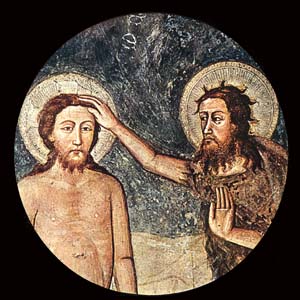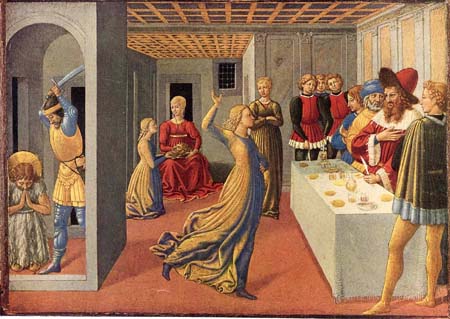 |
The Saint of the Day
St. John the Baptist, June 24
Prof. Plinio Corrêa de Oliveira
It would be interesting to analyze the aspects of St. John the Baptist’s life that characterize him as a perfect Apostle of the Last Times, as described by St. Louis Grignion de Monfort. Not because his times were the last times, but because they were the last times of that era.

St. John baptizing Our Lord |
St. John the Baptist was the person sent by God to lay straight the way of the Lord, to prepare for the coming of Jesus Christ, to act in the last times before the Messiah. The Apostle of the Last Times also must prepare for the coming of Our Lord; he will also have to act in the last times before the second coming of the Messiah. There is a parallel between these two men, just as there is a parallel between the first and the second coming of the Messiah.
The parallel between the time of Christ and the last times is very clear in the Gospel when Our Lord spoke about the fall of the Temple of Jerusalem from two different perspectives. First, He spoke about the material destruction of the Temple of Jerusalem, a prophecy that was fulfilled historically by Titus in the year 70. He also spoke of the destruction of the Temple from a symbolic perspective, referring to the end of world, of which the Temple was a symbol.
There are two destructions of the Temple, two comings of Our Lord, two men sent by God to prepare the way of the Lord. The first was St. John the Baptist and the last will be Elias, the Prophet. These two men are the models, the paradigms, the prototypes of the Apostles of the Last Times.
In one part of the Fiery Prayer by St. Louis Grignion de Monfort, he describes the Apostles of the Last Times, pointing to those men who will live in a tragic situation: “Ah, let me cry out everywhere: Fire! Fire! Fire! Help! Help! Help! Fire even within the sanctuary!”
The same kind of warning was given by St. John the Baptist, a prophet who pictured the moral situation of his time as extremely bad. He did not fear to tell the truth to the Scribes and Pharisees. He was not afraid to censure the Jewish people for the moral decadence into which they had fallen. He did not tremble to spell out to Herod the evil he had done – and this would be the cause of his death.
St. John the Baptist was a man who accomplished his duty of telling the truth about the situation in which he lived, the entire truth, completely, fearlessly, even to his death.

The beheading of St. John the Baptist |
Also worth of note is the polemic character of the mission. The Apostles described in the Fiery Prayer are fighting men, men of the polemic. During his whole life St. John the Baptist was also a polemicist. His life was but one long polemic to prepare the way of Our Lord.
In a parallel way, one can consider how his mission was well grounded in reality. St. John the Baptist fully measured the defects of men. He had a complete understanding of the effects of original sin. This is why he was always warning people about those defects and inviting them to penitence and to change their lives. Metanoia is the Greek word that means a total conversion, a complete changing of one’s life; it summarizes well the goal of St. John the Baptist’s preaching. When one reads St. Louis de Monfort describing man as vainer than toads, more ferocious than tigers, falser than serpents, and so on, one hears something of the preaching of the Apostles of the Last Times, and also the
preaching of St. John the Baptist.
The humility of the Apostles of the Last Times described by St. Louis in the Fiery Prayer can also be compared with the extreme humility of St. John the Baptist. He had that wonderful saying: “There cometh after me, one mightier than I, the latchet of whose sandals I am not worthy to stoop down and loose,” referring to Our Lord. And also this one: “He must increase, but I must decrease.”
His mission was to announce the Messiah. Therefore, once the Lamb of God had arrived, the prophecy of St. John Baptist was fulfilled, and his public mission decreased as he headed toward his martyrdom. On the contrary, Our Lord would increase until the complete fulfillment of His divine mission. The humility of St. John the Baptist was rewarded. After his martyrdom, his name was covered with glory. Our Lord said that no man born from woman was greater than he. It is impossible to have a higher praise or more honorable glorification. But this glory had as its foundation his most profound humility. Also, the humility of the Apostles of the Last Times will be rewarded, since the men who will fight the last battle against the Antichrist will be considered so great that Our Lord will permit them to pass directly to Heaven, without experiencing death.
In these points, therefore, one can see a parallel between the mission of St. John the Baptist and the Apostles of the Last Times, namely Elias, the greatest of them.
You could ask me: Where is the devotion of St. John Baptist to Mary? What place did Our Lady have in his preaching?

John the Baptist leaps in his mother's womb at hearing the voice of Mary |
Only later would Our Lady become manifest to the piety of the faithful. Her action in the Church intensified only after Our Lord ascended to Heaven and left her here to influence the destiny of the Church. The mission of St. John the Baptist was not to preach directly about Our Lady. But in his life, there was an important event. When Our Lady went to visit St. Elizabeth, he had the great fortune to hear the voice of Our Lady and feel a joy from within the womb of St. Elizabeth. The latter, after hearing the salutation of Mary, told her that her infant had leaped with joy in her womb. He was, therefore, a soul intensely turned toward Mary. Hearing her voice, he understood her, loved her and leaped
with joy.
There is a solid tradition in the Church that says St. John the Baptist was purified of original sin shortly after he was conceived, while still in the womb of St. Elizabeth. So, this episode of the Gospel referring to the child in the womb hearing Our Lady’s voice, understanding her words and loving her is completely credible.
It is probable that as a relative of Our Lady, St. Elizabeth would have gone to visit her many times, bringing her child along with her. Also, after the death of St. Elizabeth, it is probable that St. John the Baptist would often have visited Jesus and Mary.
Then, it is also probable that every time he heard the voice of Our Lady, he would have experienced the same joy he felt the first time. It would be a continuation of that same exultation. It is probable that he never forgot that elation and that it always remained in his soul as a kind of permanent consolation.
Let us venerate St. John the Baptist as a model of the perfect devotee of Our Lady, as a model of the Apostles of the Last Times, and as a man of fight. Let us ask him to grant us graces to fulfill our vocation, which is similar in so many ways with that of those Apostles. Principally, we should ask him for the grace to always exult when Our Lady speaks some word in the interior of our souls inviting us to be closer to her.


  | | Prof. Plinio Corrêa de Oliveira | |
The Saint of the Day features highlights from the lives of saints based on comments made by the late Prof. Plinio Corrêa de Oliveira. Following the example of St. John Bosco who used to make similar talks for the boys of his College, each evening it was Prof. Plinio’s custom to make a short commentary on the lives of the next day’s saint in a meeting for youth in order to encourage them in the practice of virtue and love for the Catholic Church. TIA thought that its readers could profit from these valuable commentaries.
The texts of both the biographical data and the comments come from personal notes taken by Atila S. Guimarães from 1964 to 1995. Given the fact that the source is a personal notebook, it is possible that at times the biographic notes transcribed here will not rigorously follow the original text read by Prof. Plinio. The commentaries have also been adapted and translated for TIA’s site.
|
Saint of the Day | Home | Books | CDs | Search | Contact Us | Donate

© 2002- Tradition in Action, Inc. All Rights Reserved
|
 |
|